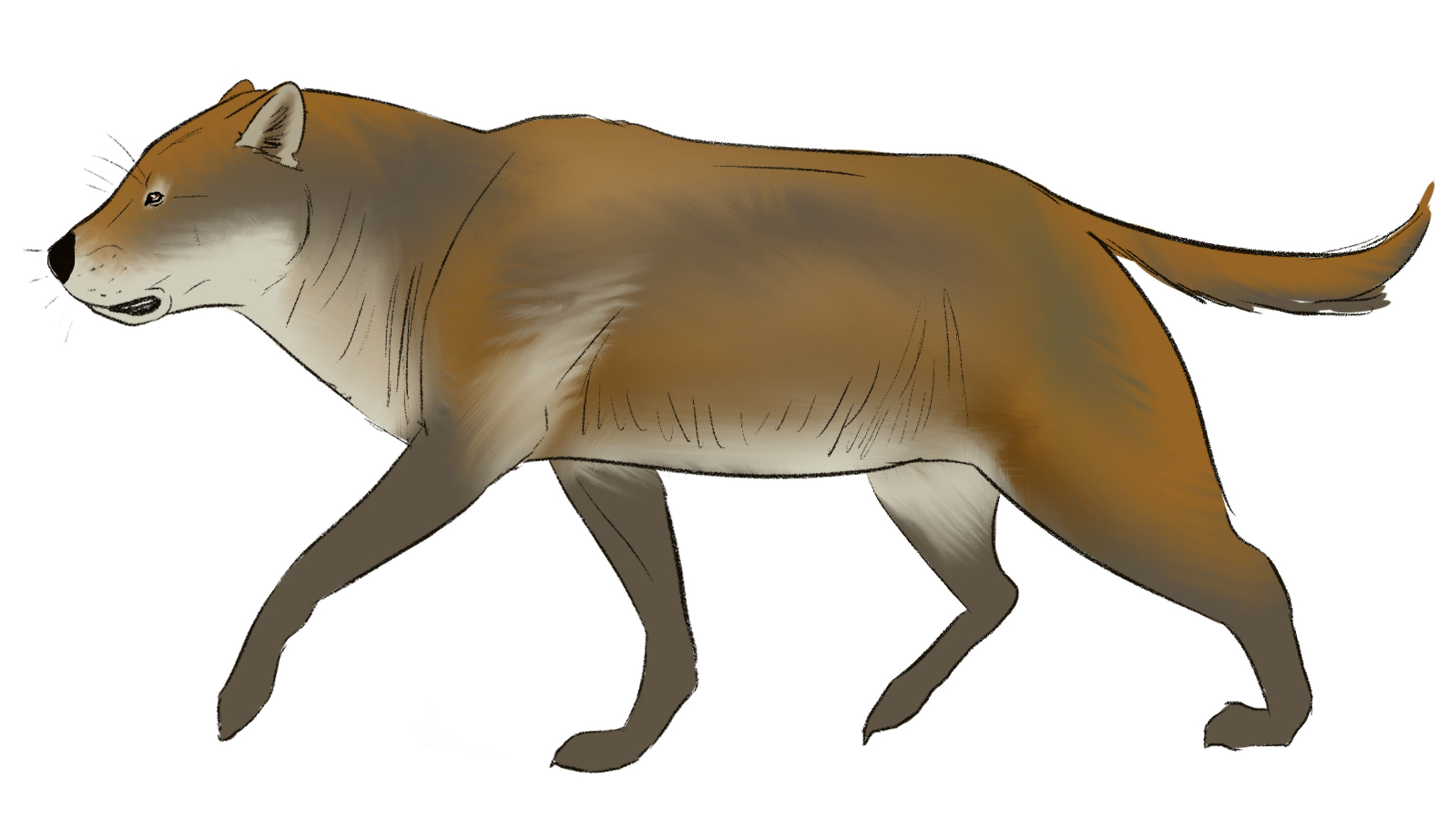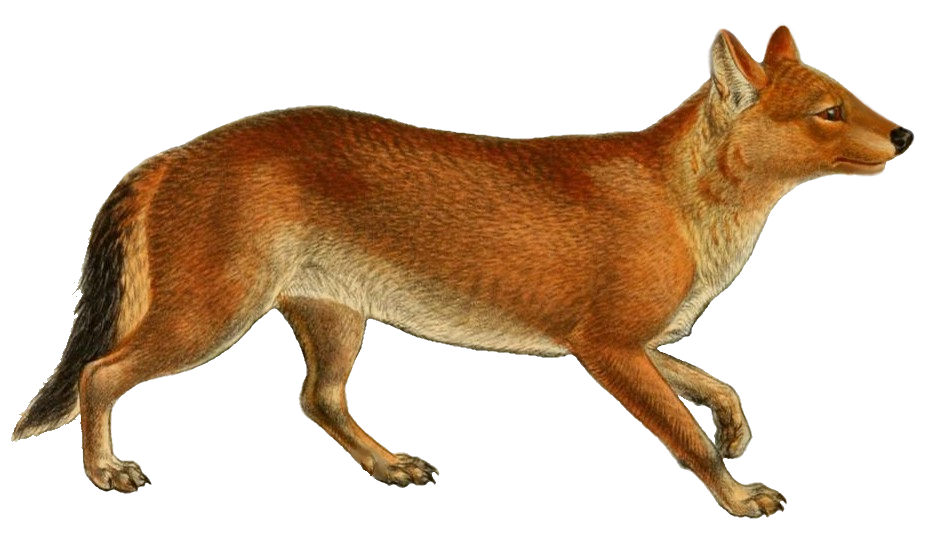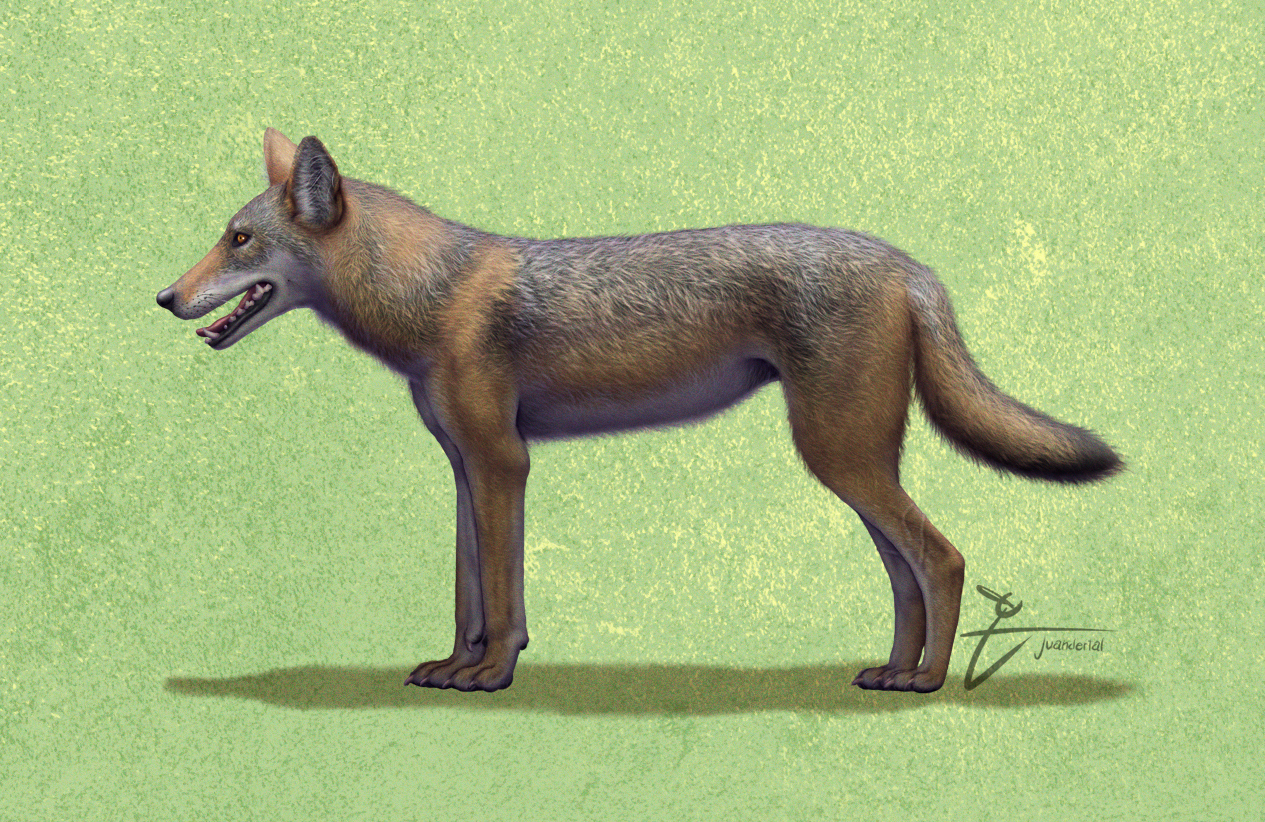|
Canidae
Canidae (; from Latin, ''canis'', "dog") is a family (biology), biological family of caniform carnivorans, constituting a clade. A member of this family is also called a canid (). The family includes three subfamily, subfamilies: the Caninae, and the extinct Borophaginae and Hesperocyoninae. The Caninae are known as canines, and include Dog, domestic dogs, Wolf, wolves, coyotes, raccoon dogs, Fox, foxes, jackals and other species. Canids are found on all continents except Antarctica, having arrived independently or accompanied by Human, human beings over extended periods of time. Canids vary in size from the gray wolf to the fennec fox. The body forms of canids are similar, typically having long muzzles, upright ears, teeth adapted for cracking bones and slicing flesh, long legs, and bushy tails. They are mostly social animals, living together in family units or small groups and behaving co-operatively. Typically, only the dominant pair in a group breeds and a litter of young ... [...More Info...] [...Related Items...] OR: [Wikipedia] [Google] [Baidu] |
Borophaginae
The extinct Borophaginae form one of three subfamilies found within the canid family. The other two canid subfamilies are the extinct Hesperocyoninae and extant Caninae. Borophaginae, called "bone-crushing dogs", were endemic to North America during the Oligocene to Pliocene and lived roughly 34—2.5 million years ago, existing for about . Origin The Borophaginae descended from the subfamily Hesperocyoninae. The earliest and most primitive borophagine is the genus '' Archaeocyon'', which is a small fox-sized animal mostly found in the fossil beds in western North America. The borophagines soon diversified into several major groups. They evolved to become considerably larger than their predecessors, and filled a wide range of niches in late Cenozoic North America, from small omnivores to powerful, bear-sized carnivores, such as '' Epicyon''. Species There are 66 identified borophagine species, including 18 newly identified species that range from the Orellan to Blancan ag ... [...More Info...] [...Related Items...] OR: [Wikipedia] [Google] [Baidu] |
Cuon
The dhole ( ; ''Cuon alpinus'') is a Canidae, canid native to South Asia, South, East Asia, East and Southeast Asia. It is anatomically distinguished from members of the genus ''Canis'' in several aspects: its skull is convex rather than concave in profile, it lacks a third lower molar (tooth), molar, and the upper molars possess only a single Cusp (dentistry), cusp as opposed to between two and four. During the Pleistocene, the dhole ranged throughout Asia, with its range also extending into Europe (with a single putative, controversial record also reported from North America) but became restricted to its historical range 12,000–18,000 years ago. It is now extinct in Central Asia, parts of Southeast Asia, and possibly the Korean peninsula and Russia. Genetic evidence indicates that the dhole was the result of reticulate evolution, emerging from the Hybrid (biology), hybridization between a species closely related to genus ''Canis'' and one from a lineage closely related ... [...More Info...] [...Related Items...] OR: [Wikipedia] [Google] [Baidu] |
Otocyon
The bat-eared fox (''Otocyon megalotis'') is a species of fox found on the African savanna. It is the only extant species of the genus ''Otocyon'' and a basal species of canid. Fossil records indicate this canid first appeared during the middle Pleistocene. There are two separate populations of the bat-eared fox, each of which makes up a subspecies. The bat referred to in its colloquial name is possibly the Egyptian slit-faced bat (''Nycteris thebaica''), which is abundant in the region and has very large ears. Other vernacular names include big-eared fox, black-eared fox, long-eared fox, Delalande's fox, cape fox, and motlosi. It is named for its large ears, which have a role in thermoregulation. It is a small canid, being of comparable size to the closely related cape fox and common raccoon dog. Its fur varies in color depending on the subspecies, but is generally tan-colored and has guard hairs of a grey agouti color. The bat-eared fox is found in Southern and East Af ... [...More Info...] [...Related Items...] OR: [Wikipedia] [Google] [Baidu] |
Caninae
Caninae (whose members are known as canines () is the only living subfamily within Canidae, alongside the extinct Borophaginae and Hesperocyoninae. They first appeared in North America, during the Oligocene around 35 million years ago, subsequently spreading to Asia and elsewhere in the Old World at the end of the Miocene, some 7 million to 8 million years ago. Taxonomy and lineage The genus ''Leptocyon'' (Greek: ''leptos'' slender + ''cyon'' dog) includes 11 species and was the first primitive canine. They were small and weighed around 2 kg. They first appeared in Sioux County, Nebraska in the Orellan era 34-32 million years ago, which was the beginning of the Oligocene. This was the same time as the appearance of the Borophaginae with whom they share features, indicating that these were two sister groups. Borophaginae skull and dentition were designed for a powerful killing bite compared with the ''Leptocyon'' which were designed for snatching small, f ... [...More Info...] [...Related Items...] OR: [Wikipedia] [Google] [Baidu] |
Canis
''Canis'' is a genus of the Caninae which includes multiple extant taxon, extant species, such as Wolf, wolves, dogs, coyotes, and golden jackals. Species of this genus are distinguished by their moderate to large size, their massive, well-developed skulls and dentition, long legs, and comparatively short ears and tails.Heptner, V. G.; Naumov, N. P. (1998). ''Mammals of the Soviet Union'' Vol.II Part 1a, SIRENIA AND CARNIVORA (Sea Cows, Wolves and Bears). Science Publishers, Inc. USA. pp. 124–129. . Taxonomy The genus ''Canis'' (Carl Linnaeus, 1758) was published in the 10th edition of Systema Naturae and included the dog-like carnivores: the domestic dog, wolves, coyotes and jackals. All species within ''Canis'' are Phylogenetics, phylogenetically closely related with 78 chromosomes and can potentially hybrid (biology), interbreed. In 1926, the International Commission on Zoological Nomenclature (ICZN) in Opinion 91 included Genus ''Canis'' on its ''Official Lists and Indexes o ... [...More Info...] [...Related Items...] OR: [Wikipedia] [Google] [Baidu] |
Hesperocyoninae
The extinct Hesperocyoninae are one of three subfamilies found within the canid family. The other two canid subfamilies are the extinct Borophaginae and extant Caninae. Taxonomic history Hesperocyoninae are basal canids that gave rise to the other two canid subfamilies, the Borophaginae and Caninae. This subfamily was endemic to North America, living from the Duchesnean stage of the Late Eocene through to the early Barstovian stage of the Miocene, lasting around 20 million years. It comprises 10 recognized genera and 26 recognized species. Four major lineages can be defined based on shared characteristics: *'' Mesocyon''-'' Enhydrocyon'' clade (includes '' Cynodesmus, Sunkahetanka, Philotrox'') *'' Osbornodon'' clade *'' Paraenhydrocyon'' *'' Ectopocynus clade'' The genus '' Caedocyon'', which is only known from a single partial cranium that shows some ''Paraenhydrocyon'' affinities, probably represents another independent lineage. '' Hesperocyon'', which lacks the shar ... [...More Info...] [...Related Items...] OR: [Wikipedia] [Google] [Baidu] |
Coyote
The coyote (''Canis latrans''), also known as the American jackal, prairie wolf, or brush wolf, is a species of canis, canine native to North America. It is smaller than its close relative, the Wolf, gray wolf, and slightly smaller than the closely related eastern wolf and red wolf. It fills much of the same ecological niche as the golden jackal does in Eurasia; however, the coyote is generally larger. The coyote is listed as Least Concern, least concern by the International Union for Conservation of Nature, due to its wide distribution and abundance throughout North America. The species is versatile, able to adapt to and expand into environments modified by humans; urban coyotes are common in many cities. The coyote was sighted in eastern Panama (across the Panama Canal from their home range) for the first time in 2013. The coyote has 19 recognized subspecies. The average male weighs and the average female . Their fur color is predominantly light gray and red or fulvous int ... [...More Info...] [...Related Items...] OR: [Wikipedia] [Google] [Baidu] |
Wolf
The wolf (''Canis lupus''; : wolves), also known as the grey wolf or gray wolf, is a Canis, canine native to Eurasia and North America. More than thirty subspecies of Canis lupus, subspecies of ''Canis lupus'' have been recognized, including the dog and dingo, though grey wolves, as popularly understood, only comprise Wild type, naturally-occurring wild subspecies. The wolf is the largest wild Neontology, extant member of the family Canidae, and is further distinguished from other ''Canis'' species by its less pointed ears and muzzle, as well as a shorter torso and a longer tail. The wolf is nonetheless related closely enough to smaller ''Canis'' species, such as the coyote and the golden jackal, to produce fertile Canid hybrid, hybrids with them. The wolf's fur is usually mottled white, brown, grey, and black, although subspecies in the arctic region may be nearly all white. Of all members of the genus ''Canis'', the wolf is most Generalist and specialist species, specializ ... [...More Info...] [...Related Items...] OR: [Wikipedia] [Google] [Baidu] |
Vulpes
'' Vulpes '' is a genus of the subfamily Caninae. The members of this genus are colloquially referred to as true foxes, meaning they form a proper clade. The word "fox" occurs in the common names of all species of the genus, but also appears in the common names of other canid species. True foxes are distinguished from members of the genus ''Canis'', such as domesticated dogs, wolves, jackals and coyotes, by their smaller size (5–11 kg), longer, bushier tail, and flatter skull. They have black, triangular markings between their eyes and nose, and the tip of their tail is often a different color from the rest of their pelt. The typical lifespan for this genus is between two and four years, but can reach up to a decade. Extant species Within ''Vulpes'', 12 separate extant species and four fossil species are described: Early history The oldest known fossil species within ''Vulpes'' is ''V. riffautae'', dating back to the late Miocene of Chad, which is within the Neogene ... [...More Info...] [...Related Items...] OR: [Wikipedia] [Google] [Baidu] |
Fennec Fox
The fennec fox (''Vulpes zerda'') is a small fox native to the deserts of North Africa, ranging from Western Sahara and Mauritania to the Sinai Peninsula. Its most distinctive feature is its unusually large ears, which serve to dissipate heat and listen for underground prey. The fennec is the smallest fox species. Its coat, ears, and kidney functions have Xerocole, adapted to the desert environment with high temperatures and little water. The fennec fox mainly eats insects, small mammals and birds. It has a life span of up to 14 years in captivity and about 10 years in the wild. Pups are preyed upon by the Pharaoh eagle-owl; both adults and pups may possibly fall prey to jackals and striped hyenas. Fennec families dig out burrows in the sand for habitation and protection, which can be as large as and adjoin the burrows of other families. Precise population figures are not known but are estimated from the frequency of sightings; these indicate that the fennec fox is currently ... [...More Info...] [...Related Items...] OR: [Wikipedia] [Google] [Baidu] |
Prohesperocyon
''Prohesperocyon'' ("before '' Hesperocyon''") is an extinct genus of canid, endemic to North America appearing during the Late Eocene around 36.6 mya ( AEO). Fossil distribution ''Prohesperocyon wilsoni'' was unearthed at the Airstrip (TMM 40504) site, Presidio County, Texas dating between 36.6 and 36.5 million years ago. revised on 2002-06-03, John Alroy
John Alroy is a paleobiologist born in New York in 1966 and now residing in Sydney, Australia.
Area of expertise
Alroy specializes in diversity curves, speciation, and extinction of North American fossil mammals and Phanerozoic marine inverte ... . ...
[...More Info...] [...Related Items...] OR: [Wikipedia] [Google] [Baidu] |







